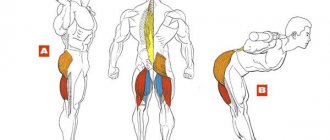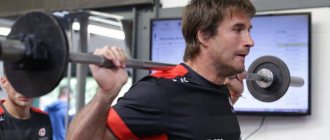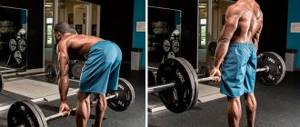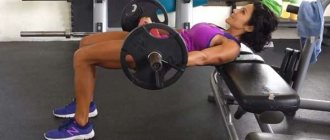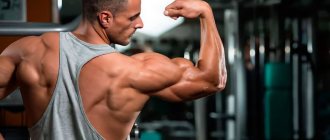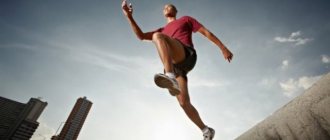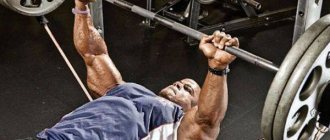Benedikt Magnusson is arguably the best weightlifter in the world (although Eddie Hall would certainly argue with that). He broke the world belt deadlift record and was almost able to lift 500kg. This has only been achieved once in history. Introducing Benedikt Magnusson's deadlift program, narrated by Stefan Selvi, a colleague of the Icelandic strongman.
Week A
- The deadlift warms up to approximately 80%
- 80% 8 sets x 2 reps
- Deadlift platform about 8-10 cm high.
- Train with weights from 40-70%
- 4-6 sets x 4 reps. At speed!
- Then reduce to about 40-50% 2 sets x 8 reps
Week B
- Deadlift. Do up to 3 repetitions maximum.
- Deadlift platform about 8-10 cm high.
- With scales from 50-75%
- 4-6 sets x 3-5 reps. At speed!
- Then reduce to about 50% for 2 sets x 8 reps
Week C
The Jeff Jett Deadlift Method... If you deadlift the Jeff Jett Method, you start by pulling from the rack. Then your training partners remove the rack and you go down and then up! And then your partners put the stand back in! The set starts from your hips, then you lower and rise again (I hope you understand how to do this exercise).
One guy from America told us about this technique. His name is Jeff Jet. We started using it because with any weight Benedict and I lift, we can do a lot of reps! So we thought this would be a great way to work with a lot more weight to shock the body! It worked!
- Jeff Jett Deadlift Method - Lift to Max for 1-3 Reps
- Deadlift platform about 8-10 cm high.
- 4 sets of 4-6 reps with weight 50-60%
Details
We do deadlifts every week. The last 3 or 4 workouts before the competition we just do regular deadlifts from the floor and work singles. However, we never lift a weight heavier than the starting weight for a competition. Remember, on race day you want to be your strongest!
conclusions
As you can see, the second training program is quite vague. We get the impression that Magnusson has a good understanding of what works for him, but doesn't follow a set routine from a specific strength coach. The results speak for themselves.
Magnusson and his brother were genetically designed to lift very heavy weights. If you are going to follow his program, you will have to edit it to suit your needs. Even if this technique does not help you lift 500 kg, we guarantee that you will be able to lift much more weight than usual.
Hone your technique
Many athletes believe that by strengthening their quadriceps, glutes, and back muscles, they can increase their one-time deadlift maximum. This statement has the right to life, but there is one caveat. If you think that the problem is in these muscles, then it is better to reconsider your execution technique. If the technique is honed to the point of automaticity, then improved results are not far off.
Let's learn how to do deadlifts correctly:
- Your legs should be shoulder-width apart and your feet parallel to each other.
- Bend down and grab the barbell (there should be about 50 cm between your hands).
- Bend your legs, push your chest forward, arch your lower back, and push your pelvis back.
- Lift the projectile without putting its pressure on your toes. The bar should be closer to your feet.
- After lifting the working weight, pause for 1 second.
- Slowly lower the barbell to the floor.
By following the tips listed above, you can beat your deadlift record. The main thing is not to take excessive weights and warm up thoroughly before classes. Remember that everything has its time and everything will definitely work out for you.
The Dirty Dozen: 12 Tips to Increase Your Deadlift
Photo: 12 tips to increase your deadlift
Any healthy man under 50 years old can deadlift up to 200 kg in two years of proper training. Tony Gentilcore, a certified strength and conditioning coach and co-founder of the Cressey Performance club, tells how to do this. Known as one of New England's most innovative trainers, Tony is renowned for his intelligent approach to training and well-designed strength and conditioning exercise programs. A former successful baseball player, he holds a sports education and advanced degree and is an expert in strength training, nutrition, general and specific athlete training, and injury prevention and recovery.
My business partner, trainer Eric Crissy, made this bold statement several years ago, causing a stir in fitness circles. But it's true. If you train properly for a couple of years, you can get up to 200kg deadlift. I understand how outraged you are by this statement if you cannot yet lift two hundredweight. It's unpleasant when someone questions your worth. But what are you going to do about it? You can stop reading this material or write me a couple of insulting letters, or you can bite the bullet and continue reading to learn how to lift heavy weights. All you need to do is follow the 12 commandments.
TIP 1. IF YOU WANT TO PULL A LOT, YOU NEED TO PULL RIGHT
Let's start with an example from life. When Pete, our club's commercial director, started training a year ago, he deadlifted 40 kg. 364 days later, he confidently lifted 180 kg. Here's an example from real life.
With this in mind, start improving your deadlift technique in 8 simple steps.
- The legs are slightly narrower than the shoulders, the bar is near the shins.
- Bring your shoulder blades together, push your chest forward, inhale deeply and tighten your abs. Bend your knees slightly and lean forward, moving your pelvis back, while maintaining a arch in your lower back (to do this, stretch your tailbone toward the ceiling). The shoulder blades are together all the time. I teach my clients to push their pelvis back until they reach the bar. Try not to just sit down.
- Grab the bar and squeeze as hard as you can, keeping your shoulders back and down toward your tense lats. This helps activate the thoracolumbar fascia and stabilize the back. You should also keep your glutes and hamstrings tight.
- Don't lower your head, raise your chin - choose a point on the wall 3-4 meters in front of you and fix your gaze on it throughout the entire movement.
- Keeping your arms straight, press your heels into the floor. Lift the bar off the floor, making sure that your pelvis and shoulders rise at the same time (I often see that the pelvis goes first - this is a recipe for injury, as the lower back is overloaded).
- As you approach full extension, end the lift by contracting your glutes, pushing your pelvis slightly forward. This will take the pressure off your lower back. But don't overdo it. Many people end up incorrectly, pushing their pelvis too far forward and using their torso to pull the barbell back, excessively arching their lower back. Otherwise, you can only injure your back.
- Lowering. This part of the exercise is difficult for some people. Start the movement not from the knee joints, but from the hip joints. Sit back, placing your weight on your heels. Leave your knees in place, push your hips back (as if you were sitting in a chair) and lower the bar along your legs.
- Remember that you always need to keep your back fixed, arched (reach your tailbone towards the ceiling), and your shoulders straightened.
TIP 2: PULL HARD AND OFTEN
No, I don't mean that you have to do it every day. But if you want to pull a lot, then you have to, you know, pull.
I recommend doing deadlifts at least once a week, preferably on a Monday when you're well rested. Next, deadlifts should be done with a small number of repetitions. Strength, especially at the very beginning, is more related to the central nervous system, which is why beginners first increase their working weights and then their muscles.
I rarely assign more than five reps per set. If you do more, your technique will deteriorate, especially for beginners. Also, enough is said in the sports literature that training in a small number of repetitions teaches the body to better transmit nerve impulses, activate more motor units and improve intra- and intermuscular coordination.
THREE-MONTH PROGRAM TO IMPROVE YOUR STANDBY
I usually create programs based on the individual needs of the trainee, but a simple example to start with might look like this.
Month 1: Trap Bar Row Week 1: 5 x 5 Week 2: 4 x 5 Week 3: 6 x 5 Week 4: 3 x 5
Month 2: Sumo Deadlift Week 1: 4 x 3 Week 2: 3 x 3 Week 3: 3 x 3, 2 x 5 Week 4: Leg Block Row, 3 x 10
Month 3: Classic Deadlift Week 1: 3 rep max (or 1 rep max) Week 2: 4 x 4 Week 3: 4 x 5 Week 4: 3 x 4
After 12 weeks of heavy deadlifting, I recommend taking a week or two off from deadlifting. Do asymmetrical exercises (see below), flex your biceps, and eat plenty of animal protein.
TIP 3. CHANGE THE EXERCISES (JUST NOT EVERY WEEK)
While I understand the importance of incorporating a variety of deadlift variations into your programs (especially the ones you're lagging behind), you shouldn't change the exercise every week. In my opinion, it is better to do cycles lasting 3-4 weeks, changing the deadlift option about once a month.
TIP 4. ELIMINATE YOUR WEAK POINTS
Some people (myself included) are too slow in lifting the barbell off the platform. Others find it easier to take off, but find it more difficult to lift up once the bar passes the knees. In any case, you need to determine what you are doing worse and work on it.
Much depends on the length of the limbs (the action of the levers). Those with long arms and legs may find it easier to deadlift, but they actually have more difficulty lifting and straightening. If this sounds like you, try adding explosive rows and heavy plate rows with partial amplitude to correct it.
For those with a longer torso and relatively shorter arms and legs, lifting off is more difficult. Pulling from an elevated position with increased amplitude will help you (stand on a stand 2-10 cm high). When you return to regular deadlifting, the liftoff will be better. Also, the sumo option is more suitable for you, since it reduces the distance covered by the barbell.
TIP 5. TAKE YOUR SHOES LOOSE
Anyone who has read Christopher McDougall's amazing book, Born to Run, knows that the shoe industry makes $20 billion a year in fraud. In our club, everyone does deadlifts barefoot.
Without shoes you are 1-5 cm closer to the ground, i.e. the bar passes 1-5 cm less. Also, without shoes, you apply more pressure with your heels, which allows you to more effectively engage the muscles of your buttocks and hamstrings.
If you work out in a gym where clients are not allowed to take off their shoes, it is better to use sneakers or other lightweight shoes for deadlifting that will not interfere with you like leg shackles.
TIP 6. AVOID Wrist straps
Not everything is so simple here. On the one hand, many people use wrist straps constantly. Block pulls with straps? I am begging you. On the other hand, grip strength really prevents someone from progressing, in which case wrist straps should be used. At our club, we typically use wide (snatch) grip straps for deadlifts.
It is better to pull with a different grip, changing hands in each approach and using magnesium. If you cannot use magnesium in your gym, look for another gym or use it secretly. Place it in a plastic box in your bag and sneak a little onto your hands. After yourself, of course, wipe down the fretboard.
ADVICE 7. IF YOU WANT TO GET STRONGER, YOU NEED TO TRAIN WITH STRONG PEOPLE
Like, if you want to sell better, you need to communicate more with sellers. Or, if you want to give up women, you need to communicate more with pick-up artists.
So, I have no scientific evidence, but I am personally convinced that testosterone drops by 144.37% every time a trendy pop singer is heard on the radio. How can you lift a heavy barbell when next to you are skinny metrosexuals pumping their biceps in a squat rack, and housewives puffing on treadmills?
Rule of thumb: If you have more Smith machines in your gym than power racks, you're more likely to win the lottery than become super strong.
TIP 8: DO LEADING EXERCISES TO INCREASE YOUR DEADLIFT EFFECTIVENESS
To become stronger in the deadlift, you need to thoroughly strengthen all the muscles in the back of your body. Unfortunately, you can’t do just leg presses on a machine, leg bends and extensions. When I do backbends (hyperextensions) properly, the pull always increases. For me, this is almost a “marker” - when the working weights increase in bending, I can predict the growth in deadlifts.
For you it might be overhead squats, for someone else it might be Romanian deadlifts. The point is to find that exercise, the result of which “defines” the deadlift.
TIP 9. DO ASYMMETRICAL EXERCISES
They help lift heavy weights. When my clients get better at single leg exercises, they always see improvements in their deadlift and squat.
As my colleague Mike Boyle has repeatedly noted, single-leg exercises activate unilateral muscles that are underutilized in double-leg exercises. This is a complex of adductors, the gluteus medius of the working leg and the quadratus lumborum muscle on the side of the other leg. These muscles are very important for stabilizing the knee and hip joints and are activated when we perform unstable exercises on one leg.
In short, if these stabilizer muscles are not strengthened, you will not be able to lift anything heavy. So do asymmetrical exercises on one leg, and thank me later.
TIP 10. MAKE YOUR BUTT MUSCLES WORK!
We all know (or should know) how important a proper warm-up is. Moreover, I also wrote about how much I love doing light, muscle-activating stretches that I do between sets of the same exercise. So instead of listening to music or staring at the blonde working out next door, you too can get in some healthy moves while resting between sets of deadlifts.
Most of us don't pay enough attention to our buttock muscles. Because we sit on them for 8 to 12 hours every day, these muscles are weak and constricted. If we remember that these are the strongest extensor muscles of the pelvic girdle, it becomes clear how their condition affects the amount of weight we lift in the deadlift. In other words, some of you lift less in deadlifts because you don’t engage your gluteal muscles well.
I encourage you to do a couple of simple asymmetrical movements to activate your glutes between sets of deadlifts. The result will be an increase in weight on the bar during the deadlift.
TIP 11. DON’T ACCUDY YOUR BODY TO FAILED REPS
What bothers me the most are clients who try to raise more than they can. I can understand that this happens to everyone sometimes, but not in every training session. Enough has been said about the need for hard work and self-improvement, but constantly failing will only frustrate your nerves and lead to disappointment.
TIP 12. DO EXPLOSIVE EXERCISES
Many guys have heard of the conjugate method, which is promoted by trainer Louie Simmons from the Westside Barbell club. This technique combines maximal strength exercises with speedy, explosive variations of the Big Three exercises (squat, bench press, and deadlift). One training day is dedicated to maximal force (lifting heavy barbells), the other is dedicated to dynamic force (lifting lighter barbells quickly).
I already talked about the need for hard work in tip 2, now let's talk about the dynamic versions of the deadlifts. Research says that noticeable gains are seen when done at 40% of your 1RM, which is why you often see recommendations for 40-65% of your 1RM for this method.
I must say that I suffered for a long time, creating and explaining a program of explosive exercises for people over 30-35 who have not trained before, not to mention young guys who are just approaching 100 kg in the deadlift. However, we needed to find a way to make them more explosive.
And one day we came across a kettlebell swing. I have to say that just a few months ago I was very skeptical about this comeback of kettlebells. For me, it was just a newfangled hobby that everyone does, but sooner or later they will abandon and forget. However, after several seminars with coaches Mike Robertson and Dan John, I changed my mind. Without going into too much detail, Dan says this exercise has a great, continuous progression from a squat at the starting point to a full extension with hips moving forward at the end. With all due respect to the deadlift, the kettlebell swing develops more explosive power and teaches the movement better, improving technique!
The only problem is that many people finish the lift incorrectly, without straightening their body. It is not at all surprising that many people have back pain after performing such swings. Guess why! So to help you perform the kettlebell swing correctly, here are a few notes about trainer Mike Robertson's mistakes.
Tip: Think of each rep as a separate set. Most guys, after a few repetitions, become loose and start bouncing the bar off the floor. The repetitions are getting worse and worse and even my spine is starting to hurt. The deadlift is called a deadlift for a reason. Once you lower the bar to the floor, regroup, inhale again, tighten your abs, roll out your chest, roll your shoulders back, etc., repeat everything perfectly.
As you approach full extension, end the lift by contracting your gluteal muscles, pushing your pelvis slightly forward. This will take the pressure off your lower back. But don't overdo it. Many people end up incorrectly, pushing their pelvis too far forward and using their torso to pull the barbell back, excessively arching their lower back. Otherwise, you can only injure your back.
SUMO DEADLIFT
Strengthens the adductor muscles, which help stabilize the legs and pelvic girdle and protect the knee joints from injury.
In the starting position, your legs are wider than your shoulders, your feet are turned outward, and your knees are aligned with your toes. Bend your legs, moving your pelvis back, and grab the bar. In this version, the pelvis must be kept slightly lower before lifting. The technique is the same - shoulder blades together, chest forward, look ahead and lift, straining your buttocks at the top of the exercise.
Hyperextension - the beginning of the movement and the end of the movement. Take a weight in your hands or place a not very heavy barbell on your shoulders, holding it with your hands. Bend down. Bend over, feel the tension in your lumbar muscles, and only then lift your shoulders up. Keep your shoulder blades together, chest forward. We rose to the same line with our legs - and down again. Breathing is arbitrary
Exercises for the back, hamstrings, and other pelvic girdle muscles, such as the leg row (in my opinion, one of the most underrated exercises in general), should make up a large part of the set of building exercises
ASYMMETRICAL EXERCISES
Lean against the wall, lift your bent leg (without arching or rounding your lower back) and press the heel of your other leg into the floor. Hold this tension for two seconds, squeezing the gluteal muscles of your supporting leg. Then repeat the same with the other leg and do a total of five sets per leg.
Lie on your back with your legs bent and press your heels into the floor. Raise your pelvis slightly, squeezing your buttocks. Then lift one leg and straighten it, without lowering your pelvis.
Hold this position for one second, then lower your leg and repeat with the other leg. There are also five approaches in total.
SIX WAYS TO SPOIL MAX WEIGHTS
1. You simply bend down and lift the kettlebell up, rather than sitting down while working your legs.
2. You are not bringing the kettlebell back as far as possible when lowering (as far as possible towards the groin).
3. You do not keep your chest out and your back straight throughout the movement.
4. You don't finish the movement fully extended. Try to end the movement with simultaneous straightening of the hip and knee joints.
5. You are too tense throughout the movement. Remember that tension is needed when fixing at the top and when moving the weight back at the bottom. In the intervals between these positions you should not strain.
6. You are not describing an arc with the kettlebell. Many beginners swing the kettlebell too loosely. Focus on the precise range of motion, firmly holding the kettlebell in the top and bottom positions. And you definitely don't strain your buttocks in an extended position to take the pressure off your lower back.
What will The Dirty Dozen do for you? Well, isn't it time for you to set a new personal record in the deadlift? Use all my tips, check your technique and work hard, and I'm sure you'll love your new progress in the coming months.
We would like to express our gratitude to the fitness club “TERRASPORT Copernicus” for their assistance in conducting the shooting, personal trainer Alexander Kuranov and Svetlana Veprintseva for providing information support.
Why do deadlifts
Most beginners prefer to focus on their arms and chest. At the same time, they avoid training their legs and back, considering them less important for themselves, and training them is difficult. However, this is completely wrong.
Exercises for the muscles of the legs and back must be included in the training, and the deadlift is one of the main movements here. Its regular implementation will allow you to achieve several goals at once:
- Thanks to the strengthening of the back and legs, it will be possible to work standing and sitting with heavy weights, with almost no risk of injury; in particular, with developed long muscles, the load on the spinal column is reduced;
- The deadlift is a heavy exercise that uses a large number of muscle groups, and it produces a powerful metabolic response, causing even muscles not involved in the deadlift, such as the biceps, to grow faster;
- The body will develop proportionally, that is, thanks to the deadlift, the lag of the muscle groups of the legs and back can be avoided.
Muscles involved
The deadlift is a movement that works almost every muscle. Some of them are directly responsible for lifting the projectile, while the rest stabilize the position of the body. The main work is carried out by:
- Adductor muscles of the thighs;
- hamstrings;
- Gluteal muscles;
- Long back muscles;
- Latissimus dorsi muscles.
Deadlift with dumbbells
In bodybuilding, deadlifts can be performed not only with a barbell, but also with dumbbells. In terms of technique and muscles worked, this option has virtually no differences. It allows athletes who are tired of working with a barbell to diversify their workouts. In addition, it can be performed at home by anyone who does not have this equipment, but has dumbbells of suitable weight.
When performing deadlifts with dumbbells, you must follow the technique even more strictly than when working with a barbell. You need to maintain balance and keep a bend in the lower back, lower your arms down perpendicular to the floor, and the weights should be located not in front, but on the sides of your legs.
Types of deadlifts
Row with contour bar
This option is performed in the same way as the classic one, there are no differences in technique. Using a contour bar allows you to work the target muscles more effectively, giving a better load. Also, while pulling with this projectile, there is less chance of injury.
Sumo deadlift
The sumo deadlift requires a wide stance of the legs; they should be positioned so that the feet are near the plates. The main part of the load is taken by the hips.
Deadlift
Another name for the exercise is straight-legged deadlift. Thanks to its implementation, the gluteal muscles and the muscles of the back of the thigh, that is, the biceps of the thighs, are tightened. When performing a deadlift, your legs should be almost straight; throughout the entire approach, they should be kept slightly bent at the knee joints. The body extends upward due to the work of the back muscles, the muscles of the legs do not contract or relax, but are under strong tension.
Recommendations for choosing the type of deadlift
The choice of one of the types of exercise depends on which muscles need to be emphasized. Since fitness equipment involves a fairly large number of possible options, with the help of deadlifts you can work out both your legs and your back.
It is also necessary to take into account the level of physical fitness and anatomical features. For example, it is better for beginners to pay attention to deadlifts with a contour bar rather than a straight bar. The classic version is preferable for those with short arms and poorly developed legs, while the sumo deadlift is preferable for athletes with long arms and a weak back.
